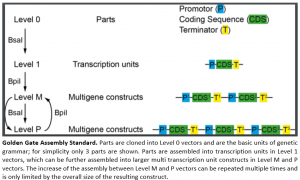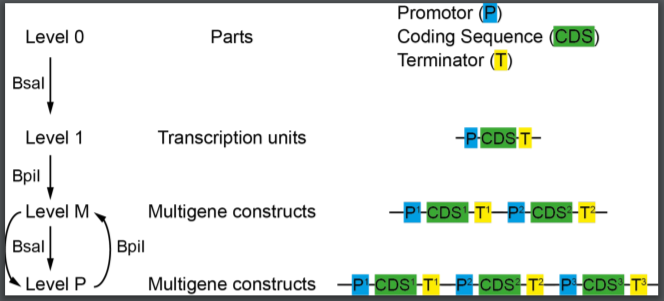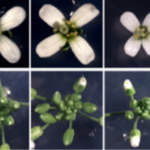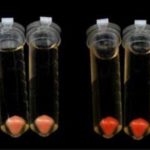A Bridge Between Kingdoms: Introduction of a Golden Gate-based Tool Kit for Cyanobacteria
One goal of synthetic biology is to build artificial pathways for bioengineering of high value compounds. To this end, pathways are not only split into individual reactions, but the expression of one enzyme is also split into individual parts (e.g., promotors, ribosomal binding sites, coding sequences, and terminators) that are used to optimize flux through the whole pathway. Testing a multitude of combinations of these parts for one step of a pathway would involve numerous cloning steps, which is further increased if whole pathways are built. Traditional cloning methods are too inefficient and laborious for these synthetic biology approaches.
To facilitate more efficient high-throughput cloning, the Golden Gate cloning system was developed (Engler et al., 2008; Weber et al., 2011)(Figure). This system relies on Type IIS restriction enzymes that cut outside of their recognition sequence. These enzymes can generate a high degree of specificity for a ligation reaction from one digestion reaction with 256 theoretically possible 4-nucleotide overhangs. This not only allows these enzymes to be used in a high-throughput setting, but also facilitates the assembly of multiple parts into one construct with the correct order and orientation, when the same 4-nucleotide overhangs are used at the end of one part and the beginning of the next. This allows for easy assembly of multiple combinations, if alternate parts have the same 4-nucleotide overhang. Another advantage of the system is that although it was developed by a company (Icon Genetics), it does not contain proprietary tools and reagents, and even more novel parts have been developed and made freely available since publication of the initial tool kit. A Golden Gate-based tool kit for plants, containing vectors and 96 standardized parts, including promotors, terminators, and tags, was subsequently developed (Engler et al., 2014).
 In this issue of Plant Physiology, Vasudevan et al. (Vasudevan et al., 2019) describe the modification of the plant Golden Gate tool kit for use with cyanobacteria. Cyanobacteria are photosynthetically active bacteria and, through an endosymbiosis event, are the most likely progenitor for the plant chloroplast. For this reason, they can help us further understand photosynthesis in plants. Additionally, cyanobacteria have great potential as a photoautotrophic bioengineering platform and the Golden Gate tool kit will certainly benefit the development of cyanobacteria strains that produce high value compounds.
In this issue of Plant Physiology, Vasudevan et al. (Vasudevan et al., 2019) describe the modification of the plant Golden Gate tool kit for use with cyanobacteria. Cyanobacteria are photosynthetically active bacteria and, through an endosymbiosis event, are the most likely progenitor for the plant chloroplast. For this reason, they can help us further understand photosynthesis in plants. Additionally, cyanobacteria have great potential as a photoautotrophic bioengineering platform and the Golden Gate tool kit will certainly benefit the development of cyanobacteria strains that produce high value compounds.
The authors established vectors for assembly of components for transient expression or integration into the genome. They also developed a multitude of individual parts such as 21 terminators and 12 native (Synechocystis sp. PCC 6803) and 33 heterologous/synthetic promotors, which were tested in the cyanobacteria model organisms Synechocystis sp. PCC 6803 and Synechococcus elongatus UTEX 2973. This large suite of promotors allows the user to choose a desired expression strength for a construct. Moreover, as random integration of constructs into the genome can lead to growth disturbances, linker sequences were developed that target integration of the constructs to neutral sites that have minimal to no consequences for the organism. Finally, the CRISPR/Cas9 system is included as a part that can either be used to generate knock-out mutants or introduce specific mutations with guide RNAs, although the latter was not demonstrated in this publication.
The development of this CyanoGate will hopefully not only further our knowledge of how photosynthesis in cyanobacteria compares to photosynthesis in plants, but will also help us establish cyanobacteria as a photoautotrophic production host for high-value compounds that benefit human health and development without the harmful byproducts of chemical synthesis.
Figure Legend:
Golden Gate Assembly Standard. Parts are cloned into Level 0 vectors and are the basic units of genetic grammar; for simplicity only 3 parts are shown. Parts are assembled into transcription units in Level 1 vectors, which can be further assembled into larger multi transcription unit constructs in Level M and P vectors. The increase of the assembly between Level M and P vectors can be repeated multiple times and is only limited by the overall size of the resulting construct.
LITERATURE CITED
Engler C, Kandzia R, Marillonnet S (2008) A one pot, one step, precision cloning method with high throughput capability. PLoS One 3: e3647
Engler C, Youles M, Gruetzner R, Ehnert T-M, Werner S, Jones JDG, Patron NJ, Marillonnet S (2014) A Golden Gate Modular Cloning Toolbox for Plants. ACS Synthetic Biology 3: 839-843
Vasudevan R, Gale GAR, Schiavon AA, Puzorjov A, Malin J, Gillespie MD, Vavitsas K, Zulkower V, Wang B, Howe CJ, Lea-Smith DJ, McCormick AJ (2019) CyanoGate: A modular cloning suite for engineering cyanobacteria based on the plant MoClo syntax. pp.01401.02018 {https://doi.org/10.1104/pp.18.01401}
Weber E, Engler C, Gruetzner R, Werner S, Marillonnet S (2011) A Modular Cloning System for Standardized Assembly of Multigene Constructs. PLOS ONE 6: e16765




